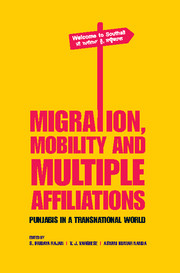Book contents
- Frontmatter
- Contents
- List of Tables and Figures
- Preface
- Acknowledgements
- Transnational World and Indian Punjab: Contemporary Issues
- Part I A Historical Survey
- Part II Shifting Contours of Migration
- Part III Social Structures and Organizational Links
- 8 The Ambiguity of Punjabi Transnationalism: Caste and Development within a Transnational Community
- 9 Punjabi Diasporas: Conceptualizing and Evaluating Impacts of Diaspora–Homeland Linkages
- 10 Punjabi Immigrant Organizations in the UK and their Transnational Connections
- Part IV Education and Migration
- Part V Family Networks
- Contributors
- Index
10 - Punjabi Immigrant Organizations in the UK and their Transnational Connections
from Part III - Social Structures and Organizational Links
Published online by Cambridge University Press: 05 March 2016
- Frontmatter
- Contents
- List of Tables and Figures
- Preface
- Acknowledgements
- Transnational World and Indian Punjab: Contemporary Issues
- Part I A Historical Survey
- Part II Shifting Contours of Migration
- Part III Social Structures and Organizational Links
- 8 The Ambiguity of Punjabi Transnationalism: Caste and Development within a Transnational Community
- 9 Punjabi Diasporas: Conceptualizing and Evaluating Impacts of Diaspora–Homeland Linkages
- 10 Punjabi Immigrant Organizations in the UK and their Transnational Connections
- Part IV Education and Migration
- Part V Family Networks
- Contributors
- Index
Summary
Introduction
Transnational associations constitute the organizational framework of diasporas. They mediate the relationships between immigrant communities and the host and receiving states and societies. They emerge and evolve to take in charge the specific needs of migrants, which are not fulfilled by local institutions. Immigrant associations have, for long, been exclusively analysed with regards to their role in the integration process. But a growing wealth of research has highlighted their importance in cross border connections (Morales and Jorba, 2010; Portes, Escobar and Arana, 2008; Pries and Sezgin, 2012), not only with the origin country, but also with other settlement countries. For this reason, migrant organizations and their activities are to be understood not only in relations with local dynamics, but also with regards to their inscription within cross-border transnational fields. A transnational organizational field is understood as a set of interrelated organizations, which are tied together either by relationships of cooperation or of enmity. By this notion, the author asserts that migrant organizations are not isolated entities, but that their activities and evolution cannot be understood outside the relationships with the other organizations of their field. This term is preferred to the one of civil society, more contested by transnational scholars (Faist, 2000, 323) and students of Indian organizations.
This chapter is based on a three-year research supported by the Volkswagen Foundation.
This account distinguishes three main periods. The first one, from the origin of migration in the UK until the mid-70s, saw the establishment of the first generation of Punjabi organizations in the UK. In those times, Indian organizations proved to be a leading force during the British civil right movements of the 60s and 70s. The second period, during the 80s, is a period of transition marked by the civil war in Punjab and the surge of the Khalistani movement (a movement supportive of the independence of Punjab during the Indo-Punjab civil war in the late 90s). The ‘Khalistani movement’ acted as a transition period during which the civil society reconfigured. A closer look at the functioning of the associations reveals why mass organizations from the 60s and the 70s faced difficulty to take the ‘transnational turn’ of the 90s, while, conversely, ethno-political organizations became increasingly global. From the early 90s onwards, the Punjabi associational field crystallized into its contemporary features.
- Type
- Chapter
- Information
- Migration, Mobility and Multiple AffiliationsPunjabis in a Transnational World, pp. 260 - 278Publisher: Cambridge University PressPrint publication year: 2015



